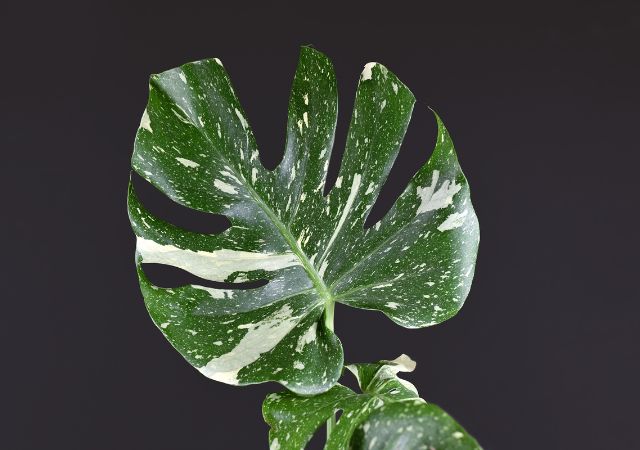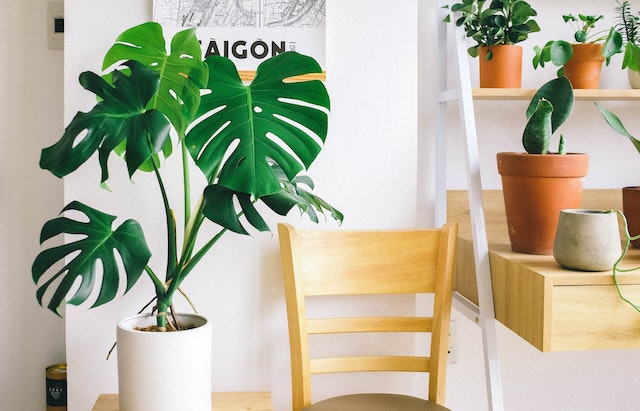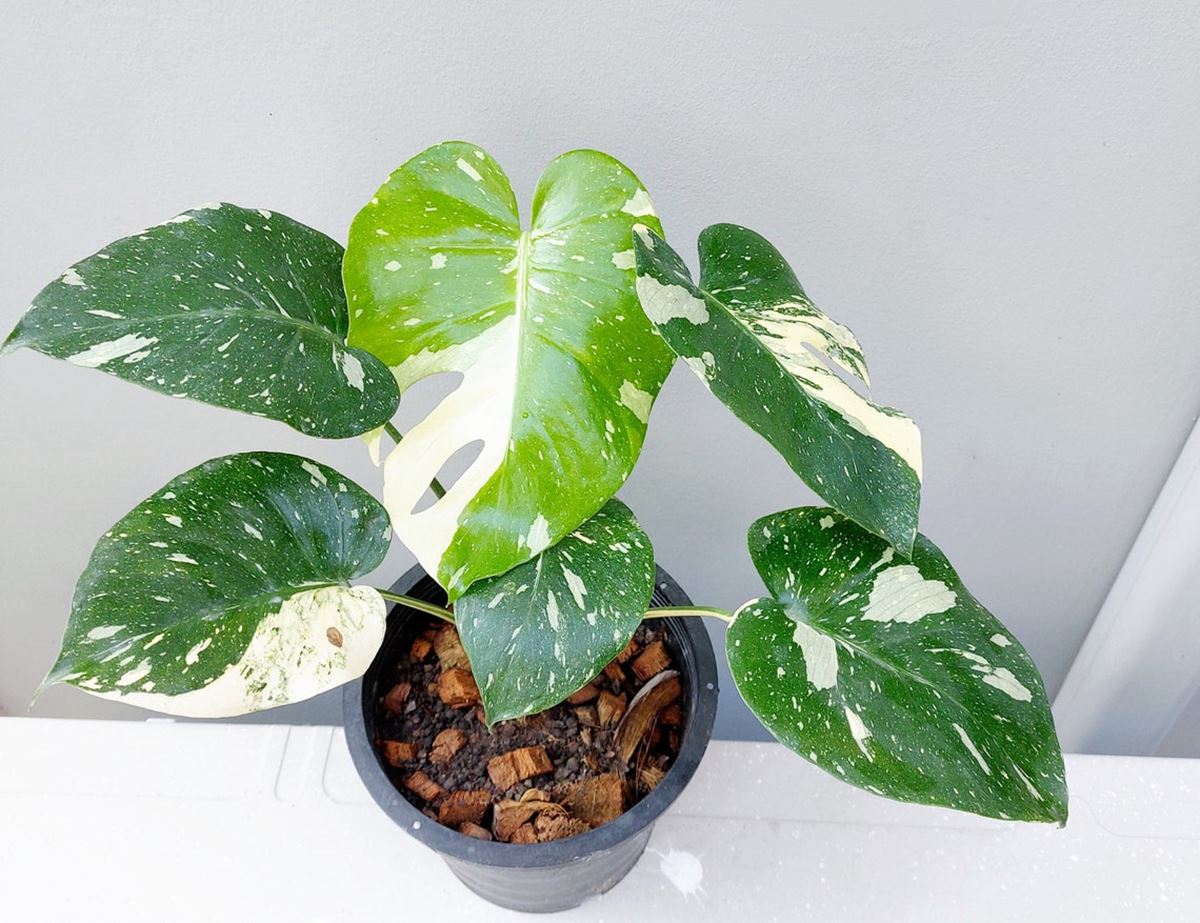If you’re in the market for a fenestrated plant, you’ll probably hear two names pop up: borsigiana and Thai constellation.
Although both houseplants share the same jaw-dropping profile of dense cordate leaves, they’re not the same. From variegation patterns to average cost, there are a few factors that might sway you one way or the other.
To help you identify the right pick for your home, we’ve set up a thorough Monstera borsigiana vs. Thai constellation comparison with all the core similarities and differences.
Contents
- 3 Ways the Monstera Borsigiana Are Thai Constellation Alike
- 1. They Share the Same Plant Taxonomy
- 2. Their Ideal Growing Conditions Are the Same
- 3. They’re Both Toxic
- Monstera Borsigiana vs. Thai Constellation: Key Differences
- 1. Common Names
- 2. Variegation
- 3. Foliage Color
- 4. Growth Pattern and Maximum Height
- 5. Light Requirements
- 6. Availability and Cost
- The Bottom Line
3 Ways the Monstera Borsigiana Are Thai Constellation Alike

Let’s just get one thing out of the way: Monstera borsigiana and Thai constellation have more in common than you might have expected.
As you might have guessed, “Thai constellation” is just a common name (we’ll dive into the meaning behind the name in a bit). However, once you figure out that the Thai constellation is also a Monstera, the similarities will start to make a lot of sense.
In fact, the Thai constellation and borsigiana plants have the same genus, species, and family: Monstera deliciosa, family Araceae.
What does this mean for you as a plant enthusiast? Well, this means that either way you go, you’ll end up with a perennial herbaceous plant with leathery, evergreen, and fenestrated foliage.
2. Their Ideal Growing Conditions Are the Same

The two Monstera plants are tropical at heart. So, the recommended care routine for both varieties is going to be pretty much the same.
You’ll need to keep the temperature warm (around 80°F) and maintain a decent humidity level to mimic the plant’s original habitat.
Both varieties prefer growing in neutral or slightly acidic soil under indirect light. They also share the same low-cold tolerance and will die if exposed to frost.
Generally, the borsigiana and Thai constellation plants do best in USDA zones 10-12.
3. They’re Both Toxic
The borsigiana and Thai constellation plants (and all Monstera varieties, for that matter) are toxic to pets.
After all, the foliage, roots, and stems have insoluble calcium oxalate crystals that can cause irritation if ingested.
Even the rare fruit (Monsteras don’t usually produce fruit and flowers indoors) can be toxic before it fully ripens.
Monstera Borsigiana vs. Thai Constellation: Key Differences

Putting the three similarities aside, there are a few aspects that make each Monstera variety stand out.
1. Common Names
Although the borsigiana and Thai Constellation plants share the same genus and species, they have different common names.
For one, you might hear the borsigiana referred to as:
- Swiss cheese plant
- Windowleaf
- Split leaf philodendron
As you can see, these common names are nods to the plant’s fenestrations.
What about the Thai constellation, you ask? Well, the first part refers to the plant’s origin, while the second part of the name is all about variegations.
2. Variegation
Right away, the first visual difference you’ll notice between the Monstera borsigiana and Thai constellation is the variegation.
“Constellation” actually refers to how the variegation pattern looks like stars splotched across the dark green foliage. On the other hand, the typical Monstera borsigiana’s foliage is glossy green.
There are a couple of variegated varieties of the borsigiana plant, namely the aurea variegata and the albo Monstera. At first glance, these might look too similar to the Thai constellation, but you can tell them apart by focusing on the color.
3. Foliage Color

The splashes and splatters across the Thai constellation leaves are a soft shade of cream. Meanwhile, the aurea’s variegation is yellowish, and the albo borsigiana shows white marbling.
The albo’s variegation is also usually more widespread—you might even notice half-white leaves. Keep in mind that if the leaves go all white, the plant could die due to the lack of chlorophyll.
So, even if you get a variegated variety of the Monstera borsigiana, the color can be a solid distinguishing factor.
4. Growth Pattern and Maximum Height

Although both plants are from the same family, the borsigiana arum is actually considered a vine. According to the National Gardening Association’s plant database, this Monstera variety can climb up to 12 feet.
The Thai constellation, on the other hand, can grow beyond the 75-foot marker.
That said, it’s important to note that most houseplants don’t really grow to their full potential. So, you don’t have to worry too much about the height difference if you plan to grow your Monstera indoors.
5. Light Requirements
Both Monstera varieties thrive better when you shelter them from direct light. However, the Thai constellation might benefit from extra daylight hours.
After all, the cream-colored splotches mean that the leaves have a lower amount of chlorophyll compared to the regular non-variegated borsigiana. So, the extra time under the light (either natural or artificial) can keep the photosynthesis process balanced.
You’ll know that your Thai constellation is starving for light if it doesn’t show deep fenestrations as it matures.

6. Availability and Cost
Borsigiana plants are only expensive if you get a variegated variety or a wet stick of a giant cultivar.
However, the Thai constellation is much harder to come by than the Monstera borsigiana. So, you can expect this rarity to reflect on the price tag.
To get one of those cream-variegated beauties, you might have to dig deep into Amazon or Etsy’s listings. Alternatively, you can contact a plant nursery that specializes in rare varieties, like the Rare Plant Fairy.
Keep in mind that a fully rotted Monstera (borsigiana, Thai constellation, or any other variety) might cost more than cuttings.
The good news is the Thai constellation has been gaining quite the buzz in the US lately and was even named the Tropical Plant Industry Exhibition’s Favorite New Foliage Plant back in 2020. Hopefully, it will become more available and affordable soon!
The Bottom Line
The main difference between the Monstera borsigiana and the Thai constellation is the foliage variegation. The latter has creamy splotches all over its leaves that make it seem like something vaguely galactic.
Either way, both varieties make fantastic houseplants with similar requirements. If you can care for one, you’ll probably handle the other without much trouble!





Leave a Reply